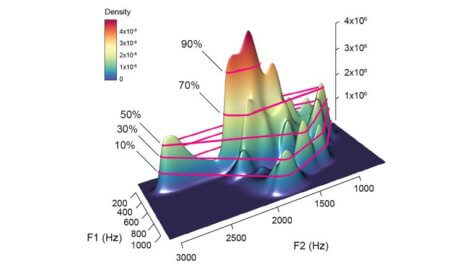(StudyFinds.org) – Communication may be the key to a healthy relationship, but is mumbling what really drives women wild? A new study finds men who don’t speak very clearly may actually have an edge when it comes to dating.
Scientists with the American Institute of Physics say males who speak less clearly (or mumble) tend to be more attractive to the opposite sex because women see it as a sign of masculinity. Conversely, men find precise pronunciation alluring because it signifies femininity.
Researchers say the findings, published in The Journal of the Acoustical Society of America, back evolutionary theories.
“From a sexual selection standpoint, males with traits that are slightly more masculine than average are typically preferred, which in this context would make males with less clear speech more attractive,” says study co-author Dr. Daniel Stehr from the University of California-Irvine in a media release.
Is mumbling the key to stardom?
Hollywood heartthrob Marlon Brando had the nickname “Mr. Mumbles” bestowed on him by his “Guys and Dolls” co-star Frank Sinatra. The Oscar-winning legend famously put cotton wool in his mouth while playing Don Corleone in “The Godfather” to make himself even less intelligible. Other leading men accused of mumbling on screen include Tom Hardy, Jeff Bridges, and the late Heath Ledger.
The UCI team have now discovered women actually like it, contrary to popular belief. They identified a “sizeable gender difference” in speech intelligibility. It has far-reaching implications in our personal lives, the workplace, and society.
“Much received wisdom and many vocal coaches would encourage people to slow down and carefully enunciate to make a better impression on their audience,” Dr. Stehr says. “However, when it comes to empirical studies of how attractiveness of the human voice is judged, we couldn’t find previous work investigating whether an actual link exists between perceived attractiveness and overall clarity of articulation.”
Speaking clearly is a turn-on, but only for men?

In previous studies, female talking samples contained fewer mistakes among volunteers asked to transcribe recorded sentences. A strong difference in a characteristic between genders is known as “sexual dimorphism.”
Vocal traits can serve as relevant cues to attractiveness, which Dr. Stehr says is a likely outcome of the forces of sexual selection. In the first analysis of its kind, scientists recorded 42 individuals while performing various speech tasks. Separate pools of participants then rated the attractiveness of the talkers. The researchers focused on “vowel space area” – a quantitative index of intelligibility – as a main acoustic feature.
Peaks on a graph correspond to different vowel sounds in each talker. As speech increases in clarity, they become larger. These changes accounted for a remarkable 73 percent of the variance in scores, but only for females. The lack of relationship between male vocal attractiveness and clearly produced speech shows a link to compelling yet paradoxical evolutionary hypotheses.
“At the same time, constricted vowel space area and lower perceived clarity is associated with a range of speech motor disorders, suggesting a lack of clarity may also have indicated the presence of disease to our ancestors,” Dr. Stehr concludes.
South West News Service writer Mark Waghorn contributed to this report.
